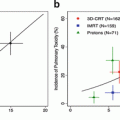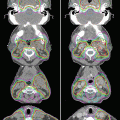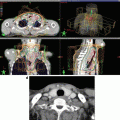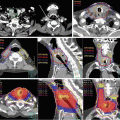© Springer Japan 2015
Yasumasa Nishimura and Ritsuko Komaki (eds.)Intensity-Modulated Radiation Therapy10.1007/978-4-431-55486-8_11. History of IMRT
(1)
Department of Radiation Oncology, James Graham Brown Cancer Center, University of Louisville, 529 S Jackson St, Louisville, KY 40202, USA
Keywords
IMRT historyIGRTTomotherapy1.1 IMRT: General Overview and Early History
There are several published historical reviews of intensity-modulated radiation therapy (IMRT), and this brief review will not recapitulate ground admirably covered by others [1–3]. The purpose of this review is to provide an experiential narrative that documents the emergence of IMRT beginning with the treatment of the first IMRT patient.
Briefly, IMRT is an advanced process of radiation therapy used to treat malignant and nonmalignant diseases. IMRT uses special beam modifiers to vary or modulate the intensity of the radiation over the field of delivery. The purpose is to manipulate the beam so that when all the radiation delivery is considered, the dose conforms closely to the tumor or target volume within the patient. IMRT may use multiple radiation beams of varying sizes and varying intensities to irradiate a tumor with precision and accuracy. The radiation intensity of each part of the beam is controlled, and the beam shape may change or multiple beams used throughout each treatment. The goal of IMRT is to shape the radiation dose to avoid or reduce exposure of healthy tissue and limit the side effects of treatment while delivering a therapeutic dose to the cancer.
Three-dimensional conformal radiation therapy (3DCRT) is a technique where the beams of radiation used in treatment are shaped to match the tumor. 3DCRT technology emerged during the 1980s as CT information became more widely available and special computer platforms were developed to model the depiction and deposition of radiation dose over a CT image template. Previously, radiation treatments matched the height and width of the tumor, meaning that substantial healthy tissue was exposed to the full strength of the radiation beams. Advances in imaging technology made it possible to visualize and treat the tumor more precisely. Conformal radiation therapy uses the CT image targeting information to focus precisely on the tumor while avoiding the healthy surrounding tissue. This exact targeting made it possible to use higher levels of radiation in treatment, which are more effective in shrinking and killing tumors.
While 3DCRT planning and delivery allows for accurate dose conformity to irregular shapes, there are still limitations in the corrections that could be made. As its name implies, intensity-modulated radiation therapy allows the modulation of the intensity or fluence of each radiation beam, so each field may have one or many areas of high-intensity radiation and any number of lower-intensity areas within the same field, thus allowing for greater control of the dose distribution with the target. Also, with IMRT, the radiation beam can be broken up into many “beamlets,” and the intensity of each beamlet can be adjusted individually. By modulating both the number of fields and the intensity of radiation within each field, we have limitless possibilities to sculpt radiation dose. In some situations, this may safely allow a higher dose of radiation to be delivered to the tumor, potentially increasing the chance of a cure [4, 5].
The concept of inverse planning for intensity-modulated radiation therapy was first elucidated by Anders Brahme [6]. His article was the first that demonstrated intensity-modulated fields of radiation would lead to more conformal dose distributions that would spare normal tissue. The first article dealt with the problem of inverse planning a target with complete circular symmetry. The article demonstrated how to generate an annulus of uniform dose around a completely blocked central circle by rotating a modulated beam profile.
Brahme later showed how inverse planning conceptually reverses the CT imaging planning process [7]. With CT, radiation beams are analyzed using a computer to produce an image. With inverse planning, the image, which is the ideal prescription for three-dimensional dose deposition, is generated by the physician as an input problem into a computer. The computer determines the position, shape, and intensity of the radiation beams (or the beamlets) to produce this ideal 3D dose delivery, thus fulfilling the prescription. Thus, the physician begins with the (ideal prescription) image and ends with the IMRT radiation beams.
The clinical implementation of forward planning IMRT is relatively easy, because it is closely related to conventional planning. Conventional forward planning mostly depends on the geometric relationships between the tumor and nearby sensitive structures. Time and effort requirements for quality assurance, planning, and delivery are similar to the experiences obtained with conformal radiotherapy. Manual definition of the segments leads to intuitive choices of the segment shapes based on the beam’s eye view option of the planning system. Forward planning IMRT continues to be useful for the breast [8] and head & neck [9].
In comparison, inverse planning is less dependent on the geometric parameters but more on specification of volumes of tumor targets and sensitive structures, as well as their dose constraints. Inverse planning is far less related to conventional radiotherapy because the segment shapes are not defined manually and the number of segments is usually considerably larger. There are on occasion complex clinical situations which require the use of many beam directions and segments. In these cases, inverse planning may be the more efficient strategy.
At this point in time, the spatial technology and physics-based solutions are more advanced than our biological technology. Although we have the capability to plan and calculate doses accurately to within millimeters (or better), we are limited in our ability to identify microscopic disease with such accuracy and precision. We are also limited by the difficulties of immobilizing a patient for the time duration of an entire IMRT treatment (typically 15–30 min). Both patients and tumors move consequent to voluntary movement and involuntary motion such as peristalsis and respiration. Additionally, patients often lose weight over the course of the treatment. This renders the dosimetry inaccurate, and at some point the planning process must be redone. The next direction in radiation oncology is to account for this movement and is being called four-dimensional (4D) conformal radiotherapy (CRT), a logical progression from 3DCRT. Researchers have recently developed megavoltage cone-beam CT (MVCBCT) for clinical use. MVCBCT will allow the reconstruction of the actual daily delivered dose based on the patient’s anatomy in real time. This will lead to “adaptive radiotherapy,” the modulation of prescription and delivery based on the actual daily delivered dose, as opposed to planned dose [10].
IMRT creates and delivers a designed and prescribed three-dimensional dose distribution within a patient. In principle, modulated beams of radiation can be projected from any direction; however, most IMRT technologies do not enjoy this level of flexibility. This discussion will only consider those technologies that use coplanar beam directions as these are commercially available. The beams may be narrow (0.5–2.0 cm) fan beams, modulated in one dimension; this delivery system is termed “tomotherapy.” The other major delivery schema uses divergent cone beams modulated in two dimensions. The modulation may be performed using milled metal (usually brass) blocks. More commonly, the modulation is accomplished by moving the leaves of the multileaf collimator. This may occur while the leaves are stationary during the time the beam is on (step-and-shoot IMRT), while the leaves move while the beam is on (dynamic MLC IMRT), or while both the leaves and the gantry move with the beam on (volumetric modulated arc therapy). For each of these techniques, delivery consists of a series of beam configurations each associated with a specific linear accelerator gantry angle. For each beam angle, a coplanar modulated beam is projected toward the isocenter.
Consider the fan beam delivery technology discussed above. The narrow beam rotation of a series of fan beams around a patient generates a dose distribution within a slice. This is conceptually analogous to the slice thickness of a CT (computerized tomography) scanner; therefore, this delivery technique was called tomotherapy. The first 2D IMRT unit consisted of add-on hardware to a conventional linear accelerator; it was the NOMOS Peacock unit [11]. Later, a helical tomotherapy unit was introduced to the marketplace, the TomoTherapy Hi-Art unit [12]. Continuing the CT analogy, to get a three-dimensional image representation of a patient from a CT scanner, it is necessary to capture and present multiple image slices. These CT slices may consist of a series of serial slices or a continuous helical slice. In order to deliver the three-dimensional IMRT dose distribution in tomotherapy, it is necessary to irradiate the serial or helical series of slices with the patient being positioned along the axis of rotation. In CT scanning, the axial resolution is limited by the slice thickness; similarly, in tomotherapy the axial resolution of the dose distribution is limited by the slice thickness. The parallels between CT scanners and tomotherapy treatment machines are seen in the ongoing development of the technology. The first applications of tomotherapy are being delivered one slice at a time, requiring accurate indexing of the patient between slices. The more modern development of helical tomotherapy in which the patient is moved continuously through the rotating fan beam can be compared with spiral (strictly helical) CT. Tomotherapy is an excellent choice for certain patient disease presentations such as head & neck cancer and some thoracic malignancies.
1.2 Early Phase, 1992–2002
Although the concept of IMRT and early algorithm for planning were developed in Sweden [6, 7], clinical application did not begin until a fully integrated IMRT planning and delivery system, namely, the NOMOS Peacock system, was invented and commissioned in 1993 by the collaborated effort between NOMOS [13–15] and Baylor College of Medicine/the Methodist Hospital (Houston, TX, USA). After obtaining investigational device exemptions and protocol approval by Baylor’s Investigational Review Board, the first patient with brain metastases was to have three brain tumors treated simultaneously using IMRT in September 1993. However, at the eve of the treatment day, an exhaustive quality assurance (QA) testing discovered a glitch in the MIMiC collimator. The treatment was therefore canceled. After modification of the sensors for the moving vanes of the MIMiC was done and correction of the glitch was achieved, the first patient with a recurrent retropharyngeal cancer was treated by the Peacock system in March 1994. The initial patients (adults and children) were those with tumors in the brain or head & neck region where rigid fixation of the head by the invasive “Talon” system was used. A detailed QA system was developed [16]. Comparison between IMRT plan and stereotactic radiosurgery plan or three-dimensional (3D) conformal plan was performed [17, 18]. Several institutions such as Tufts New England Medical Center, University of Connecticut, and University of Washington and a radiation oncology practice in Pittsburg and one in Phoenix soon began treating patients with the Peacock system.
The rollout of the NOMOS Peacock IMRT system occurred in the summer of 1995. There was a concern that this paradigm shift of treatment delivery could deliver less than a tumoricidal dose to a portion of the target each day, depending on the plan configuration. There was much discussion and debate at this conference about what was the optimal beam configuration for IMRT. There was general consensus that energy between 6 and 10 MV photons was acceptable, with the overall optimal energy being about 8 MV.
By 1996, investigators at the Memorial Sloan Kettering Cancer Center began IMRT treatment for prostate cancer with the Varian dynamic multileaf collimator [19]. By July 1997, over 500 patients in the USA have received IMRT using the Peacock system. Early results have been reported [20–23]. Institutions such as Stanford University; UC, San Francisco; University of Washington; and others (including a few in Europe) all started to investigate the clinical use of IMRT. It was gradually recognized that rigid immobilization with an invasive device was not necessary for the majority of patients. There was quite a controversy when the use of a rectal balloon for treatment of prostate cancer was introduced [24]. Nonetheless, many investigators eventually recognized the value, and later, rectal balloon was adopted for proton therapy of prostate cancer. The early reports of clinical results of IMRT were single institutional reports but provided tentative evidence of reduced toxicity with IMRT [24–27].
A few important lessons were learnt during this period:
1.
Understanding 3D anatomy on computerized tomography (CT) and magnetic resonance (MR), as well as the locoregional pathway of the spread of cancers, is of paramount importance when deciding on targets for treatment planning.
2.
Significant improvement on the understanding of partial volume organ-at-risk tolerance is needed.
3.
Treating with IMRT most tumors at a particular site (rather than just the most challenging cases) would more rapidly improve the skill, quality, and safety of the entire radiation oncology team.
4.
Using IMRT for the entire course of treatment would more likely achieve the benefit of IMRT than using IMRT as a “boost” following the conventional 2D treatment.
5.
A rotational IMRT technique could improve the treatment plan over static IMRT fields by increasing the “degrees of freedom” for beam angles.
6.
If rotational technique is used, noncoplanar beams in most instances do not significantly improve the dose distribution over coplanar beams.
7.
The flattening filter in an accelerator is not necessary for IMRT.
8.
A higher dose rate (than that in a standard accelerator), because of the large monitor units required for IMRT, is desirable.
9.
Beam energy higher than 10 MV is not necessary.
10.
An accelerated fractionation scheme could be delivered once a day without resorting to multiple fractions per day [20].
12.
Although the planning algorithm is an “inverse” process, the choice between the coverage of the target by the prescribed dose and the dose constraint to the adjacent organ(s) at risk dictates the parameter input into the planning computer to start the iteration. This is still a “forward” and somewhat “experienced-based” process.
The technical transition from conformal radiotherapy to IMRT was not always smooth. This was substantially because the two treatment systems had their own processes and terminologies. There was not a smooth path of connection between them, nor were there common terms of evaluation. There were often trade-off decisions to be made. For prostate patients, do we accept a lower rectum dose at the expense of a higher integral dose to the pelvis? Do we need and desire the dose escalation IMRT allows? Does the added complexity and cost of IMRT planning, verification, and delivery justify itself in terms of benefit to the patient? Pretreatment dose verification of the isodose curve plan became an important part of the quality assurance process, and for good reason. During the initial years of implementation, the accuracy of the treatment plan was not trusted by both physicians and physicists. Many patients were delayed and plans redone before treatment could begin with assurance of quality and safety. Today, verification hardware and software tools have made the process much more efficient, and the overall quality of IMRT delivery has substantially improved. However, more progress must be made before we see common implementation of adaptive therapy solutions [28].
Stay updated, free articles. Join our Telegram channel

Full access? Get Clinical Tree







